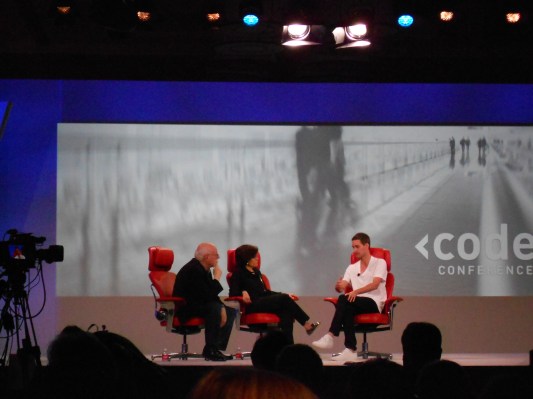You might not have to hold your finger on the screen to view your snaps in the future, says CEO Evan Spiegel.
“It’s annoying to hold your finger there,” said Spiegel, talking about the difficulty of longer video content on Snapchat. Because there’s a screenshot API now, Spiegel says that their initial ‘hack’ of having a user hold a finger on the screen to prevent screenshotting is no longer necessary. This could open up the door to longer form content in video or other kinds of media. He was reluctant to confirm directly that you wouldn’t have to hold your finger on the screen to view your snaps in the future, he did say it ‘could be’ in the cards.
Spiegel was talking in an interview today at the Code conference in Rancho Palos Verdes, Calif.
The finger-on-the-screen mechanic, which forces a user to explicitly interact with photos and videos to watch them, has been a core part of Snapchat from the beginning. Removing that requirement could significantly change the way it engages users. I’m of the mind that this intimacy actually acts as a flywheel for Snapchat’s reportedly high engagement rates.
The intimate and immediate nature of tapping to activate and releasing to stop makes it feel like you have a real physical connection to the content. So a change like this could be interesting and would likely have to have a strong rationale internally — like live streaming or episodic video outside of Discover.
It’s also a powerful selling tool when Snapchat goes to advertisers to tell them that they can literally make users touch their ads while watching stories.
Snapchat’s Discover tab, a separate product from its messenger, already plays back stories without you having to hold down a finger directly. Spiegel also danced around talking about live streaming, saying that they were watching and learning from products like Periscope and Meerkat.
For some background, a change in iOS 7 which broke the screenshot detection Snapchat originally used threw some doubt into the mix regarding its finger method. But the 11th hour addition of an official screenshot-detection API (essentially the private one made public) rescued the mechanic, which still exists in the app.
Spiegel also said that it has 100M daily active users in developed markets, and 65 percent of those users are creating content daily as well. Internally, says Spiegel, Snapchat measures its users in an hourly fashion, an unnaturally granular way to look at these statistics.
In a recent interview, Spiegel said that more than 60 percent of all-important 13-34 year-old smartphone users in the U.S. are active on the service. And they watch more than 2 billion videos every day there. Those numbers mean that Snapchat (which is one-tenth the size of Facebook) video usage is very high. This means that one person on Snapchat watches five videos for every one person on FB. Investors are so impressed with those numbers that they invested $485 million more in Snapchat in December (which had just raised a few months earlier at a $100 million valuation). This ‘rolling round’ has left them flush with cash and options — making them willing to experiment with things like ad formats and Snapchat Discover.
And part of that experimentation could lead to more or longer video content on Snapchat. Spiegel says that their forays into media publishing are an experiment that allows them to understand what publishers want.
“When we started out building discover we talked to a bunch of people that created media…but that was insanely time consuming. We realized that we needed to do it ourselves. Now, instead of traveling and asking them, we can walk across the street and ask what’s…not working.”
What they might have found was getting in the way? Your finger.
